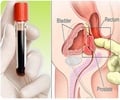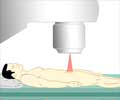AnalizaDx, Inc., a Cleveland-based biotech company has developed a new prostate cancer screening test.

The accuracy of traditional prostate cancer screening (serum prostate-specific antigen or PSA) is limited by both relatively high false positive and false negative rates. Current diagnostic strategies that use total PSA to determine the need for biopsy demonstrate false positive rates of approximately 55-75 percent. This finding can therefore lead to unneeded prostate biopsies and unnecessary worry in patients. Additionally, the serum PSA test carries, in some studies, false negative rates of up to 15 percent, meaning that some men with 'normal' PSA values actually have cancer. What is needed is a test that can more accurately predict the presence of prostate cancer on biopsy.
Working with AnalizaDx, Inc., Dr. Stovsky and colleagues studied a urine-based test that works differently than most prostate screening methods by using a novel assay to separate PSA protein structures as being linked to either a 'cancer' or 'non-cancer' pathologic diagnosis based on ultrasound guided biopsy. Instead of attempting to find a single genetic biomarker which predicts the presence of cancer, the PSA/SIA assay is based on the assumption that there may be myriad different ultra-structural changes in the PSA protein which define the cancer phenotype. The authors theorize that the extremely high sensitivity of the test is the result of the ability of the PSA/SIA biological filter to categorize the myriad ultra-structural changes in the PSA protein as being made by either cancer versus non-cancer glands. The PSA/SIA assay was also found to have relatively high specificity (low false positive) results compared to the traditional serum PSA test.
The initial study, which followed 222 men, found that the new screening method had 100% sensitivity (no false negative results) and 80.3% specificity (low false positive results). The study data was collected at three clinical sites - UH Case Medical Center, VA Boston and Cleveland Clinic, and was analyzed at the National Cancer Institute.
"This new assay is a complete departure from how the scientific community has looked at biomarkers for cancer," says Arnon Chait, CEO of AnalizaDx, Inc. "Instead of just measuring levels of proteins, we are exploring changes in structure which are associated with cancer. This new method of diagnosing cancer truly has significant potential for other types of cancer as well."
The technology will be tested in further clinical research studies to determine its accuracy in serum as well as its ability to predict cancer grade/aggressiveness and the response to curative intent therapies. Study coauthors include Lee Ponsky, Srinivas Vourganti, Peter Stuhldreher, Mike Siroky, Victor Kipnis, Olga Fedotoff, Larissa Mikheeva, Boris Zaslavsky, Arnon Chait and J. Stephen Jones. The study is dedicated to the late Martin Resnick, MD, who served as the original Principal Investigator of this work and was Chairman of the Department of Urology at UH Case Medical Center and Case Western Reserve University School of Medicine.
Advertisement







![Prostate Specific Antigen [PSA] Prostate Specific Antigen [PSA]](https://www.medindia.net/images/common/patientinfo/120_100/prostate-specific-antigen.jpg)







